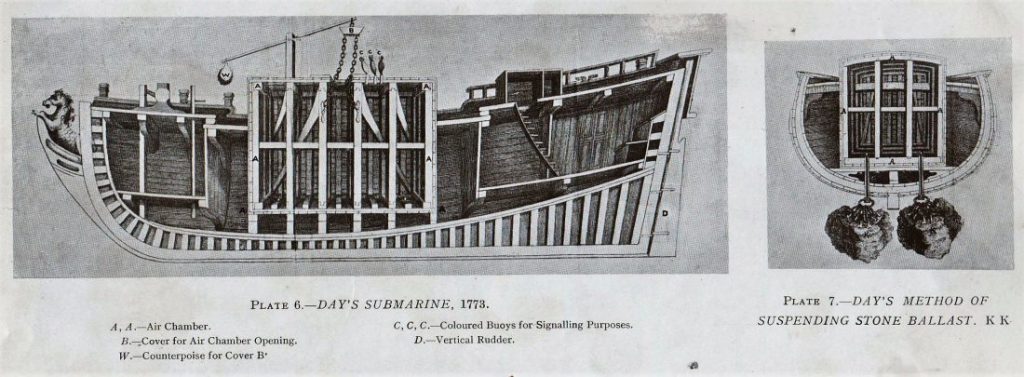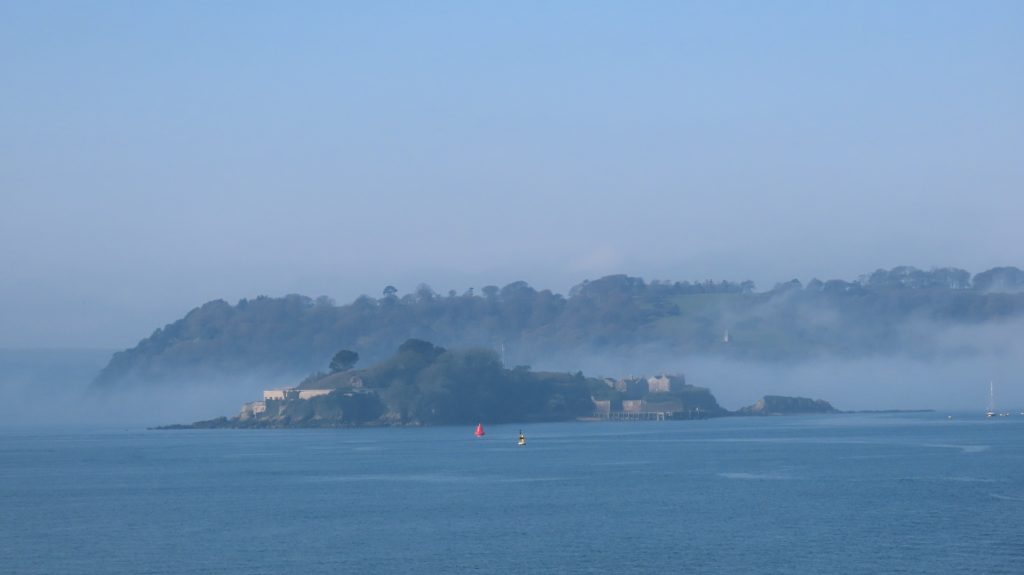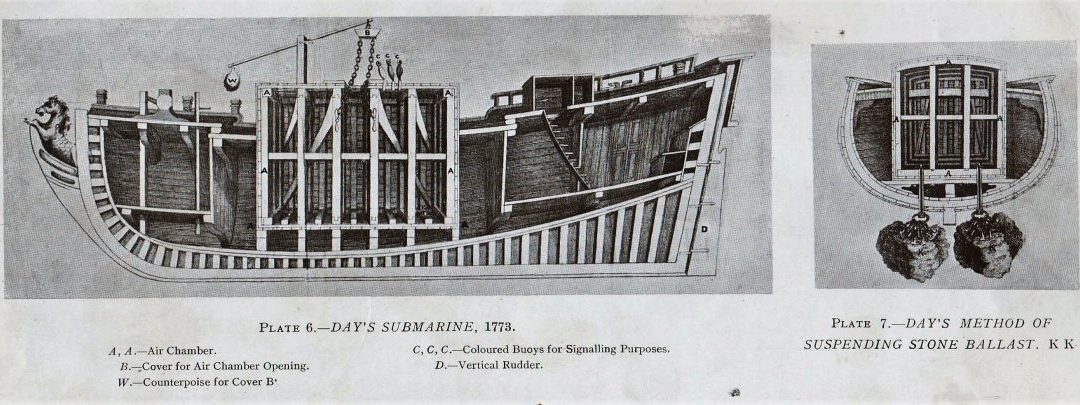The 1700’s were a period of growing connectivity between towns, cities and countries. Empire and increased trade bought meant a large amount of cash was available to some of the population, not all of which were particularly bright. There were vast opportunities for conmen to get people to invest in the first mass pyramid and Ponzi schemes as well as in funding somewhat dubious schemes based on unproven science. Of the former Britain had its South Sea Bubble and the Dutch had its Tulip Bubble where people speculated on the future price of commodities and in most cases lost all their money. Of the latter the Island would witness the first submarine fatality in the world just off her northern foreshore.
John Day was one of Britain’s examples of those reckless amateurs and one whose unfortunately flawed theories would cost him his life. A carpenter and wheelwright in Norfolk but he thought of himself as an ingenious man and had grand dreams of building a submersible chamber to make his fortune and find fame. Quite how he would make his fortune isn’t clear as the vessel would just sink and then come back up a bit later. Apparently he was a bit of an oddball described as both illiterate, indigent and obstinate in his opinions with a gloomy, mean spirited disposition. However he needed to raise some finances and get investment in his scheme. Day made it known that he took a Norwich market boat and added a small watertight compartment, took it out in the Norfolk broads and allowed the tide to submerge the vessel with him inside, remaining there for a few hours as the tide came in and out. Other reports circulated that Day claimed he’d built a watertight compartment within the guts of a disused fishing boat, filled the rest with large stones, and submerged to a depth of 300 feet for an entire 24-hour day. He claimed to have released many of the stones via an ingenious rope release system of his own design, re-establishing the buoyancy and floating to the surface. Unsurprisingly there are no recorded witnesses to either version of the story.
Despite this Day found a sponsor in a Plymouth, a well-known gambler of the time, Christopher Blake. Between them they concocted the idea of financing the venture and making a substantial profit through betting on Day being successful. Blake therefore stumped up £350 (around £55,000 nowadays) and also promised Day 10% of the winnings on bets he would be taking on the event. Having secured his investment Day then moved to Plymouth to continue build his submersible.
Day’s idea was to build a watertight chamber into the 50 ton sloop Maria. The Maria held 20 ton of ballast and two 10 ton weights were attached to the outside of the ship which could be released from inside the diving chamber. Once sealed inside a further twenty ton of ballast would be added making 60 ton in total thereby sinking the 50 ton Maria. After 12 hours Mr Day would release the two 10 ton weights and the Maria would then rise to the surface because the sloop would now hold only 40 ton and could still float with 50 ton. He would also release various coloured markers at certain times throughout his submergence to show he was ok.

However he took no account of the weight of seawater, atmospheric pressure at depth (roughly 5 times greater than at the surface at his predicted depth), the effect of tides and the action of the sea or that he would use up his oxygen. Most of these factors, although not completely understood were known at the time but it seems Day’s belief in his own ingenuity outweighed the science available. However some reports state that he did delay the attempt and make the chamber stronger just in case there was some truth behind the science as told to him by local shipwrights. Eventually however the Maria and the chamber were ready. Blake had been taking bets on Day surviving for 12 hours underwater at 130ft depth despite Day boasting he would be able to repeat his earlier feat and stay for 24 hours at 300ft.
The first part of the plan worked perfectly as on 22nd June 1774 the Maria, newly painted red, was towed out to just North of Drake’s Island between the Island and the Hoe watched by a crowd of thousands on the Hoe. The submersible chamber was equipped with a hammock and candle for light. Day clambered inside through a hole in the top of the chamber with some water and biscuits. The chamber was sealed and the last 20 ton of ballast was added as Blake moved amongst the crowd taking the final bets on the outcome. Mr Day along with the Maria disappeared under the Sound amid a large bubbling of the sea watched by a vast crowd. Unfortunately and not altogether surprisingly no coloured floats appeared at the allotted time and after 12 hours the Maria did not resurface.

Not long after the 12 hours passed the distress signal was fired and Lord Sandwich, First Lord of the Admiralty who was in Plymouth at the time ordered a rescue attempt. Attempts were made to find the Maria by dredging to then raise her but these proved fruitless and no sign of the ship was found. Blake in the meantime used the confusion to vanish along with all the stake money. I have no idea if he was ever tracked down and forced to pay out. Although one doctor at the scene immediately pronounced that Day would have died from freezing to death a London physician, Doctor Falcke, heard of the incident and rushed to Plymouth. He was convinced that if Day was still in the air-filled chamber the cold of the water might have kept “his blood in a good condition” and that animation might be suspended. If the body could be recovered before decomposition set in then Falcke believed that he could reanimate the body. With this in mind he privately initiated and funded dredging for the wreck over the next few weeks but nothing was found.
Speculation on the reason for failure varied but the likeliest explanation is the Maria and diving chamber collapsed under the pressure of the water as it sank, hence the bubbling of the water as the Maria rapidly broke apart and why a largely intact hull wasn’t found whilst trying to locate the wreck. However John Day does have the distinction of being the world’s first recorded submarine fatality.


Have any diving explorations found any trace of John Days venture ? Surviving parts of Maria’s timber structure, or the air chamber, or the stone ballast ?
Hi Anthony, although an immediate search was instigated after the accident nothing was found. A London Physician Dr Falcke paid to continue the search after it was called off and in a pamphlet he wrote claimed to have located the wreck and had brung it to the surface but it was lost again in bad weather.However there was no corroborating evidence that Falcke and his salvage crew had recovered the vessel albeit briefly. It seems more likely that the pressure of seawater had caused the Maria to break up as it descended. A few bits of red painted wood were found during the search – the Maria had been painted red – but nothing of note. As far as I know nothing more has been found which as the Sound has a high tidal range and the breakwater hadn’t been built by then is not surprising as high spring tides and storms would have meant the debris could have been shifted quite considerably.